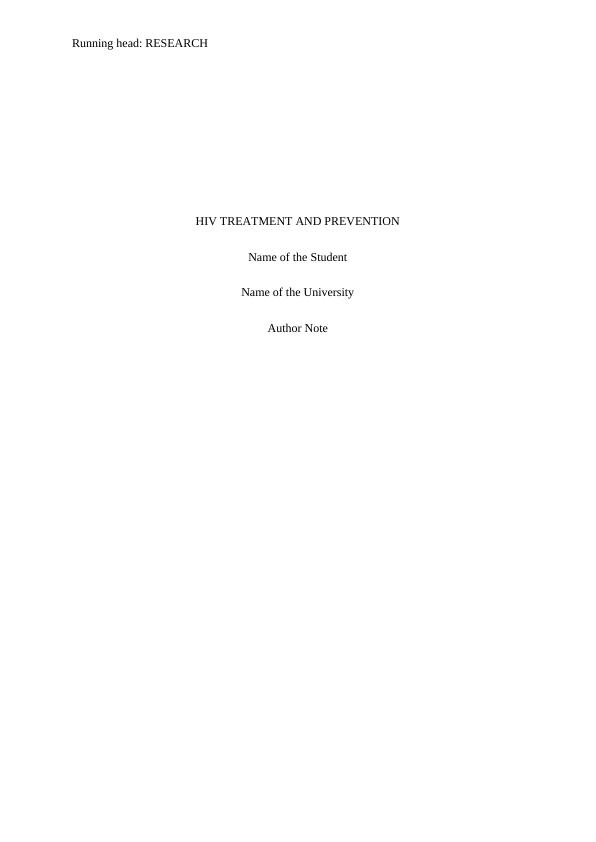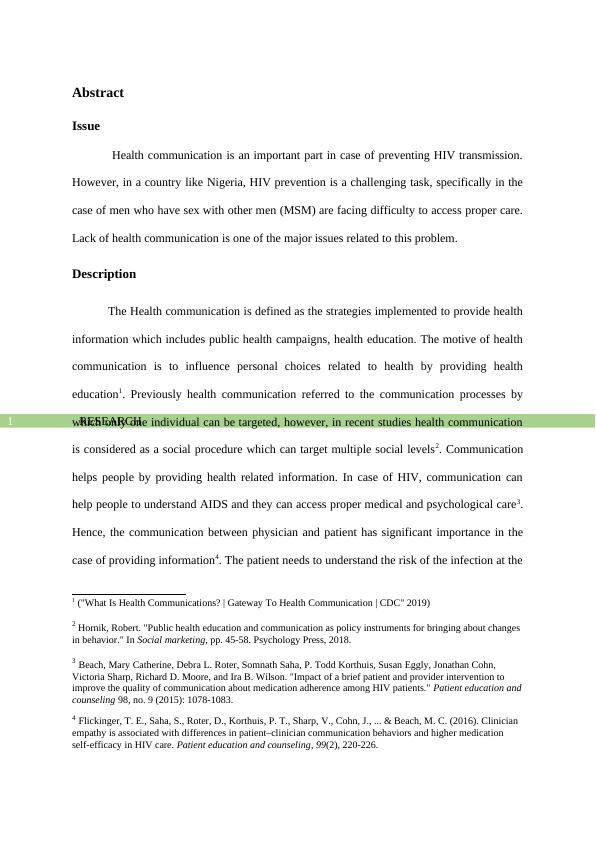HIV TREATMENT AND PREVENTION Name of the University Author Name
Added on 2022-10-17
6 Pages1097 Words469 Views
Running head: RESEARCH
HIV TREATMENT AND PREVENTION
Name of the Student
Name of the University
Author Note
HIV TREATMENT AND PREVENTION
Name of the Student
Name of the University
Author Note

RESEARCH1
Abstract
Issue
Health communication is an important part in case of preventing HIV transmission.
However, in a country like Nigeria, HIV prevention is a challenging task, specifically in the
case of men who have sex with other men (MSM) are facing difficulty to access proper care.
Lack of health communication is one of the major issues related to this problem.
Description
The Health communication is defined as the strategies implemented to provide health
information which includes public health campaigns, health education. The motive of health
communication is to influence personal choices related to health by providing health
education1. Previously health communication referred to the communication processes by
which only one individual can be targeted, however, in recent studies health communication
is considered as a social procedure which can target multiple social levels2. Communication
helps people by providing health related information. In case of HIV, communication can
help people to understand AIDS and they can access proper medical and psychological care3.
Hence, the communication between physician and patient has significant importance in the
case of providing information4. The patient needs to understand the risk of the infection at the
1 ("What Is Health Communications? | Gateway To Health Communication | CDC" 2019)
2 Hornik, Robert. "Public health education and communication as policy instruments for bringing about changes
in behavior." In Social marketing, pp. 45-58. Psychology Press, 2018.
3 Beach, Mary Catherine, Debra L. Roter, Somnath Saha, P. Todd Korthuis, Susan Eggly, Jonathan Cohn,
Victoria Sharp, Richard D. Moore, and Ira B. Wilson. "Impact of a brief patient and provider intervention to
improve the quality of communication about medication adherence among HIV patients." Patient education and
counseling 98, no. 9 (2015): 1078-1083.
4 Flickinger, T. E., Saha, S., Roter, D., Korthuis, P. T., Sharp, V., Cohn, J., ... & Beach, M. C. (2016). Clinician
empathy is associated with differences in patient–clinician communication behaviors and higher medication
self-efficacy in HIV care. Patient education and counseling, 99(2), 220-226.
Abstract
Issue
Health communication is an important part in case of preventing HIV transmission.
However, in a country like Nigeria, HIV prevention is a challenging task, specifically in the
case of men who have sex with other men (MSM) are facing difficulty to access proper care.
Lack of health communication is one of the major issues related to this problem.
Description
The Health communication is defined as the strategies implemented to provide health
information which includes public health campaigns, health education. The motive of health
communication is to influence personal choices related to health by providing health
education1. Previously health communication referred to the communication processes by
which only one individual can be targeted, however, in recent studies health communication
is considered as a social procedure which can target multiple social levels2. Communication
helps people by providing health related information. In case of HIV, communication can
help people to understand AIDS and they can access proper medical and psychological care3.
Hence, the communication between physician and patient has significant importance in the
case of providing information4. The patient needs to understand the risk of the infection at the
1 ("What Is Health Communications? | Gateway To Health Communication | CDC" 2019)
2 Hornik, Robert. "Public health education and communication as policy instruments for bringing about changes
in behavior." In Social marketing, pp. 45-58. Psychology Press, 2018.
3 Beach, Mary Catherine, Debra L. Roter, Somnath Saha, P. Todd Korthuis, Susan Eggly, Jonathan Cohn,
Victoria Sharp, Richard D. Moore, and Ira B. Wilson. "Impact of a brief patient and provider intervention to
improve the quality of communication about medication adherence among HIV patients." Patient education and
counseling 98, no. 9 (2015): 1078-1083.
4 Flickinger, T. E., Saha, S., Roter, D., Korthuis, P. T., Sharp, V., Cohn, J., ... & Beach, M. C. (2016). Clinician
empathy is associated with differences in patient–clinician communication behaviors and higher medication
self-efficacy in HIV care. Patient education and counseling, 99(2), 220-226.

RESEARCH2
time of sexual intercourse. Moreover, the patient needs to aware about the other routes of
transmission such as blood donation. The physician should involve providing the information
of the treatment to the patient. These information can reduce the chances of transmission.
Apart from physician-patient communication, there are several ways by which adequate
health communication is possible. According to a study by Taggart et al. (2015), social media
can be an important means of communication as it connects different users around the globe.
However, the study also described that maintain confidentiality be the limitation of using
social media5. Despite of these advantages of health communication in the prevention of HIV,
Nigeria is facing difficulty in implementing adequate health communication. Nigeria is one
of the countries in Africa which is highly affected by HIV/AIDS. The prevalence of HIV in
Nigeria is complicated and it differs in different regions of the country6. Young adults of
Nigeria are specifically facing high risk of HIV. Moreover, young women are facing greater
risk compared to men7. The significant factors that facilitate HIV infection are prostitution,
women trafficking, high prevalence of sexually transmitted infection and drug addiction8.
According to a report by the Government of Nigeria, 1.4% of adults aged 15-49 years are
affected by HIV9. However the result indicates a reduction in number of HIV infected adults,
still, it has a serious impact on socioeconomic progression of the country. In Nigeria, HIV
5 Taggart, Tamara, Mary Elisabeth Grewe, Donaldson F. Conserve, Catherine Gliwa, and Malika Roman Isler.
"Social media and HIV: a systematic review of uses of social media in HIV communication." Journal of medical
Internet research 17, no. 11 (2015): e248.
6 Awofala, Awoyemi Abayomi, and Olusegun Emmanuel Ogundele. "HIV epidemiology in Nigeria." Saudi
journal of biological sciences 25, no. 4 (2018): 697-703.
7 Awofala, Awoyemi Abayomi, and Olusegun Emmanuel Ogundele. "HIV epidemiology in Nigeria." Saudi
journal of biological sciences 25, no. 4 (2018): 697-703.
8 Awofala, Awoyemi Abayomi, and Olusegun Emmanuel Ogundele. "HIV epidemiology in Nigeria." Saudi
journal of biological sciences 25, no. 4 (2018): 697-703.
9 Adeyinka, Daniel A., Babayemi O. Olakunde, Olanrewaju Oladimeji, and Echezona E. Ezeanolue. "HIV
Indicator and Impact Survey: considerations for Nigeria." The Lancet HIV 6, no. 6 (2019): e348-e350.
time of sexual intercourse. Moreover, the patient needs to aware about the other routes of
transmission such as blood donation. The physician should involve providing the information
of the treatment to the patient. These information can reduce the chances of transmission.
Apart from physician-patient communication, there are several ways by which adequate
health communication is possible. According to a study by Taggart et al. (2015), social media
can be an important means of communication as it connects different users around the globe.
However, the study also described that maintain confidentiality be the limitation of using
social media5. Despite of these advantages of health communication in the prevention of HIV,
Nigeria is facing difficulty in implementing adequate health communication. Nigeria is one
of the countries in Africa which is highly affected by HIV/AIDS. The prevalence of HIV in
Nigeria is complicated and it differs in different regions of the country6. Young adults of
Nigeria are specifically facing high risk of HIV. Moreover, young women are facing greater
risk compared to men7. The significant factors that facilitate HIV infection are prostitution,
women trafficking, high prevalence of sexually transmitted infection and drug addiction8.
According to a report by the Government of Nigeria, 1.4% of adults aged 15-49 years are
affected by HIV9. However the result indicates a reduction in number of HIV infected adults,
still, it has a serious impact on socioeconomic progression of the country. In Nigeria, HIV
5 Taggart, Tamara, Mary Elisabeth Grewe, Donaldson F. Conserve, Catherine Gliwa, and Malika Roman Isler.
"Social media and HIV: a systematic review of uses of social media in HIV communication." Journal of medical
Internet research 17, no. 11 (2015): e248.
6 Awofala, Awoyemi Abayomi, and Olusegun Emmanuel Ogundele. "HIV epidemiology in Nigeria." Saudi
journal of biological sciences 25, no. 4 (2018): 697-703.
7 Awofala, Awoyemi Abayomi, and Olusegun Emmanuel Ogundele. "HIV epidemiology in Nigeria." Saudi
journal of biological sciences 25, no. 4 (2018): 697-703.
8 Awofala, Awoyemi Abayomi, and Olusegun Emmanuel Ogundele. "HIV epidemiology in Nigeria." Saudi
journal of biological sciences 25, no. 4 (2018): 697-703.
9 Adeyinka, Daniel A., Babayemi O. Olakunde, Olanrewaju Oladimeji, and Echezona E. Ezeanolue. "HIV
Indicator and Impact Survey: considerations for Nigeria." The Lancet HIV 6, no. 6 (2019): e348-e350.

End of preview
Want to access all the pages? Upload your documents or become a member.
Related Documents
HIV Research with Men who Have Sex with Men (MSM): Advantages and Challenges of Different Methods for Most Appropriately Targeting a Key Populationlg...
|10
|2753
|74
HIV/AIDS in MSM Relationships: Health Risks, Barriers to Implementation, and Recommended Strategieslg...
|1
|565
|67
The Impact of National Strategies of HIV/AIDS Among Women in South-West Nigerialg...
|11
|3817
|54
HIV/AIDS in Australia and Thailand Research 2022lg...
|6
|2513
|31
Health Economics: Analysis of HIV Prevention and Management in Indialg...
|9
|3199
|36
Social Determinants of Healthlg...
|7
|2106
|64